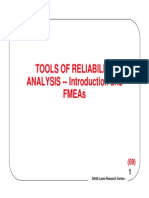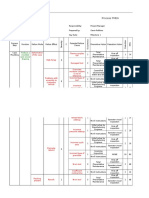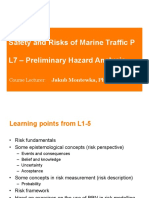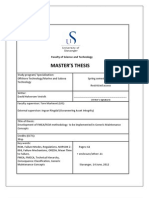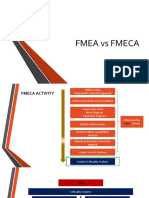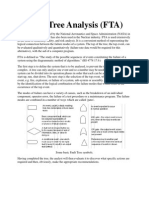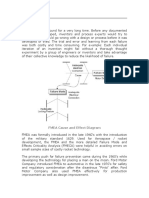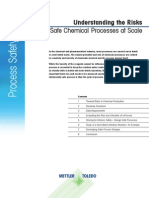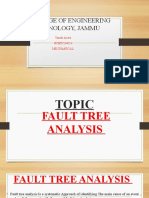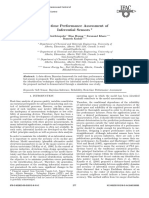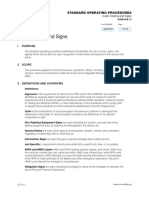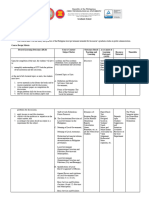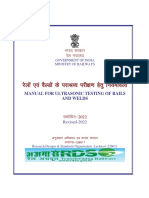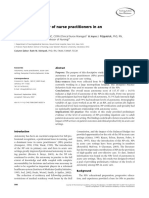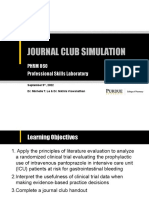Introduction to Fault Tree Analysis
in
Risk Assessment
FAULT TREE ANALYSIS
Colin S. Chip Howat Ph.D.
Kurata Thermodynamics Laboratory
Department of Chemical & Petroleum Engineering
University of Kansas
C. S. Howat Fault Tree Analysis - 2008
�Introduction to Fault Tree Analysis
in
Risk Assessment
Lecture:
Three Class Periods
Title:
Introduction to Fault Tree Analysis
Thoughts:
It is good to have an end to journey toward; but
it is the journey that matters, in the end.
Ursula K. LeGuin
The journey is the reward.
Chinese Saying
Question:
Congress has considered and will consider again
using risk assessment to evaluate the suitability
of regulations governing safety and environment.
Given what you know about the uncertainties
associated with risk evaluation, is this a suitable
tool for governing?
Purpose:
Introduce Fault Tree Analysis
Continue Scenario Path Development
C. S. Howat Fault Tree Analysis - 2008
�Introduction to Fault Tree Analysis
in
Risk Assessment
The architects . . . who relied only upon theories
and scholarship were obviously hunting the
shadow, not the substance.
Vitruvius, Book 1
Ten Books of Architecture
It is not the same to talk of bulls as to be in the
bullring.
Spanish Proverb
C. S. Howat Fault Tree Analysis - 2008
�Introduction to Fault Tree Analysis
This is the Event Tree which we developed in class to represent the Loss of
Cooling for the simple reactor system. The question is, is this all possible
routes to the runaway reactor event? The Event Tree does not tell us this.
Loss of
Cooling
Initiating Event A
Alarm
Notice
Temperature
Restart
Cooling
Automatic
Shut-down
RUNAWAY
RUNAWAY
RUNAWAY
4
C. S. Howat Fault Tree Analysis - 2008
�Introduction to Fault Tree Analysis
Event Tree Analysis
This is an inductive procedure which shows all possible outcomes resulting
from an initiating event, e.g. equipment failure or human error.
In the example, the initiating event was the loss of cooling.
What other possibilities are there for arriving at a runaway condition?
C. S. Howat Fault Tree Analysis - 2008
�Introduction to Fault Tree Analysis
Example
In order to determine the Risk, we need the frequency. For the Simple
Reactor Problem, we need to determine the frequency of all runaway
situations. For this, we need all possible paths to runaway.
Consider an example of a flat tire. What is the frequency that this will occur?
In order to answer this and other questions, we need to recognize that the
accident can be a sequence of events, each of which has its own frequency.
Tire Failure
C. S. Howat Fault Tree Analysis - 2008
�Introduction to Fault Tree Analysis
Suppose that the Flat Tire is the terminating (top?) event. How might we represent this?
Flat Tire
C. S. Howat Fault Tree Analysis - 2008
�Introduction to Fault Tree Analysis
Fault Tree Analysis is
used to find all possible
causes of an event.
Fault Tree Representation of Flat Tire
Top Event
Flat Tire
Logic Gate
A
Tire Failure
Road
Debris
Minimum Cut
Sets
3
B
Worn
Tire
Defect
1
8
Basic
Event
3
B
1
2
Minimum Sequence of Steps
to Cause Top Event from Basic
Events
C. S. Howat Fault Tree Analysis - 2008
�Introduction to Fault Tree Analysis
Fault Tree Analysis
This is a deductive technique focusing on on particular event or consequence.
The purpose is to identify all scenarios, i.e. initiating events that lead to this
consequence. In LOPA we call a scenario a cause/consequence pair. A
completed fault tree shows many scenarios, all with the same consequence.
HazOp might have been used to discover this event.
This method uses logic gates to determine the combination of equipment
failures and human errors which lead to the event. The minimum number is
determined (minimum cut sets).
~Pr(x)
9
Detailed understanding of how plant
functions, detailed process drawings and
procedures, knowledge of failure modes
and their effects.
C. S. Howat Fault Tree Analysis - 2008
�Introduction to Fault Tree Analysis
Fault Tree Analysis
Strengths -
Systematic
Minimal Cut Sets
Weaknesses -
Complete understanding required
Very Large Trees developed
Trees not unique
Education research indicates that engineers tend to be
inductive. That is, engineers prefer to go from the specific
to general. A deductive approach is from the general to
specific. The primary weakness of fault tree analysis is
that it is deductive in its approach to Hazard Evaluation.
The analyst must see the whole picture.
10
C. S. Howat Fault Tree Analysis - 2008
�Introduction to Fault Tree Analysis
Symbols Used in Fault Tree Analysis
Cond
The resulting output event requires
the simultaneous occurrence of all
input events.
AND Gate
The resulting output event requires
the occurrence of any individual
input event..
OR Gate
The output event will occur if the
input occurs and inhibit event occurs.
A fault event that needs no further
definition.
11
INHIBIT Event
BASIC Event
C. S. Howat Fault Tree Analysis - 2008
�Introduction to Fault Tree Analysis
Symbols Used in Fault Tree Analysis (cont.)
An event that results due to the
interaction of a number of other
events.
INTERMEDIATE Event
An event that cannot be developed
further due to lack of suitable
information.
UNDEVELOPED Event
An event that is a boundary
condition to the fault tree.
Out
12
In
Use to transfer the fault tree in and
out of a sheet of paper.
EXTERNAL Event
TRANSFER Symbol
C. S. Howat Fault Tree Analysis - 2008
�Introduction to Fault Tree Analysis
Fault Tree Rules
1. State what, where, when fault is.
Define Top Event.
Define Existing Events.
Define Unallowed Events.
Define the Physical Bounds of the Analysis.
Define the Equipment Configurations.
Define the Level of Resolution.
Cr
l!
a
c
iti
2. Ask whether this fault can be caused by equipment failure.
3. No miracles are allowed.
If Normal Operation propagates a fault, then assume Normal
Operation.
4. Complete the gate.
All inputs to a Gate must be defined before going to the next Gate.
5. No Gate to Gate connections are allowed.
Input to gates should be a fault.
13
C. S. Howat Fault Tree Analysis - 2008
�Introduction to Fault Tree Analysis
Fault Tree Resolution (Determining Minimum Cut Sets)
1. Uniquely Identify Gates and Basic Events.
Gates are identified with letters.
Basic Events are identified with numbers.
2. Resolve all Gates into Basic Events.
3. Remove duplicate Events within a set.
4. Delete all supersets.
Or Gate forms new line in development. And Gate forms a new column. The
resolution is complete when outcome is defined by Basic Events. See Flat Tire
analysis for a simple example.
14
C. S. Howat Fault Tree Analysis - 2008
�Introduction to Fault Tree Analysis
Qualitative Probabilities can be used
as an initial estimate of each sequence
of events.
Pr( ) Increasing
Estimating the Probability
Human Error
Active Equip
Error
Passive Equip
Error
Notes on Probability Estimation
Pr(A and B) = Pr(A) Pr(B)
Pr(A or B) = Pr(A) + Pr(B) - Pr(A) Pr(B)
Of course, we know more probabilities than implied on this slide since we have
covered LOPA and Event Tree.
15
C. S. Howat Fault Tree Analysis - 2008
�Introduction to Fault Tree Analysis
Steps
Define
Top Event
Existing Event
Unallowed Events
Physical Bounds
Equipment Configurations
Level of Resolution
Example
Top Event:
Storage Tank Overflows
16
C. S. Howat Fault Tree Analysis - 2008
�Introduction to Fault Tree Analysis
Storage Tank Overflows
What Next?
17
C. S. Howat Fault Tree Analysis - 2008
�Introduction to Fault Tree Analysis
Storage Tank Overflows
Operator Does Not Stop
Flow
High Level Shut Down
Fails
Operator not Aware of
High Level
Control
Valve
Fails
1
Level
Switch
Fails
Solenoid
Valve
Fails
Level Indicator
Failure
In
18
C1
Alarm Does Not
Go Off
In
C2
C. S. Howat Fault Tree Analysis - 2008
�Introduction to Fault Tree Analysis
C1
Out
Out
Level
Measure
Error
C2
F
Strip
Chart
Fails
Level
Measure
Error
Alarm
Failure
This completes the fault tree for the event of storage tank overfills.
Human error could be added if it were allowed. The addition point would be
before the gate D, wouldnt it? What would the addition of Human Error look
like?
19
C. S. Howat Fault Tree Analysis - 2008
�Introduction to Fault Tree Analysis
Resolution of the Fault Tree Example
The resolution of the Fault Tree is to determine the most probable
event leading to the top event.
A
A
B
1
D
D
1
1
20
C
C
C
C
C
C
C
C
C
C
2
3
2
2
2
2
3
3
3
3
E
4
5
4
4
5
5
F
F
F
4
6
4
6
4
4
5
5
4
4
5
5
4
6
4
6
4
6
4
6
This process
continues adding
a new column for
each and gate.
A new row is
added for each
or gate.
This process
continues until
all gates are
resolved into
basic events.
C. S. Howat Fault Tree Analysis - 2008
�Introduction to Fault Tree Analysis
Resolution of the Fault Tree Example
Can you prove that the minimum cut sets are:
1,2
1,3
2,4
3,4
2,5,6
3,5,6
This is accomplished by removing all duplicate steps and by recognizing which
sets contain supersets. That is those multiple steps which have as part of
them some other minimum set.
21
C. S. Howat Fault Tree Analysis - 2008
�Introduction to Fault Tree Analysis
The Columns are for Reference Only
Valving and Instrumentation Incomplete
STM
LC
CWS
TC
PI
PC
H
TA
TC
LC
KURATA THERMODYNAMICS LABORATORY
UNIVERSITY OF KANSAS
Proposed Cyclopentadiene Installation
For Discussion Purposes Only - Draft for HazOp
CWS
22
JOB:
HazOP
BY:
C. S. Howat
DATE:
3/08/04
DWG:
REV:
C. S. Howat Fault Tree Analysis - 2008
�Introduction to Fault Tree Analysis
Fault Tree Example
Stable Condition reached if Quench Valve Opens adding
material to reactor and Inlet Valve Closes
Top Event
Damage due to High Process Temperature
23
C. S. Howat Fault Tree Analysis - 2008
�Introduction to Fault Tree Analysis
Top Event?
Existing Event?
Unallowed Events?
Physical Bounds?
Equipment Considerations?
Level of Resolution?
24
C. S. Howat Fault Tree Analysis - 2008
�Introduction to Fault Tree Analysis
Damage Due to High
Process Temperature
What Next?
25
C. S. Howat Fault Tree Analysis - 2008
�Introduction to Fault Tree Analysis
Conclusions
Fault Tree Analysis -- Deductive Approach to resolve Top Events into all
possible initiating events. It is used to test the most probable sequence of
events which lead to the undesirable top event. Probabilities of undesirable
outcomes can be calculated with most probable outcome identified.
Five Rules to Fault Tree Analysis
1) Identify what, when, where fault occurs.
2) Ask whether fault can be caused by equipment
failure.
3) No miracles are allowed.
4) Complete each gate.
5) No gate-to-gate connections are allowed.
26
C. S. Howat Fault Tree Analysis - 2008



